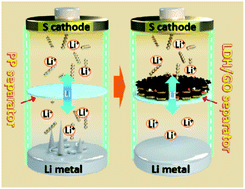An atomic-confined-space separator for high performance lithium–sulfur batteries†
Abstract
Lithium–sulfur (Li–S) batteries have attracted considerable attention as promising energy-storage devices. However, the “shuttle effect” caused by the dissolution of polysulfides always leads to a rapid loss of capacity. To overcome this issue, we successfully constructed an ultrathin separator (∼30 nm) with atomic-confined-space (∼1.1 nm) by the assembly of layered double hydroxide nanosheets (LDH NSs) and graphene oxide (GO) on a commercial polypropylene separator. Both the experimental results and molecular dynamics (MD) simulations confirm that the restricted pathways on the LDH/GO ultrathin film effectively block polysulfides but promote the uniform dispersion of Li ions. The (LDH/GO)20-assembled Li–S battery exhibits superior performance with a high initial discharge capacity (1092 mA h g−1) and excellent cycle stability (0.08% capacity decay per cycle) at 0.2C. In addition, the developed separator exhibits promising high temperature performance, which is attributed to the use of inorganic LDH and GO NSs. This work shows the promise of two-dimensional (2D) nanomaterials as efficient functional separators for Li–S batteries.



 Please wait while we load your content...
Please wait while we load your content...